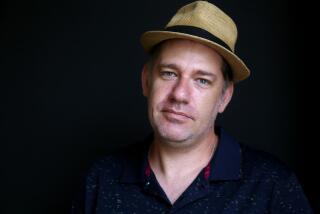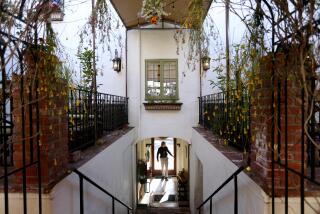Firm Plans to Carry On Poe’s Vision : Real estate: Officials, friends and critics praise the developer and his wife. They were killed Monday.
AGOURA — The death of Dale Poe, one of Southern California’s largest real estate developers, brought his family-run business to a temporary standstill this week, but will have little long-term effect on its massive projects, which are reshaping parts of the Santa Clarita and San Joaquin valleys, family members said.
Dale Poe, 61, and his wife Margaret, 54, were killed early Monday morning on their way home from a weekend in Yosemite when their car failed to negotiate a bend in California 99 and crashed into an abandoned building.
Poe’s Agoura-based Poe Development Co. was barely functioning Tuesday as family members huddled to console one another.
But a spokesman who returned a call to The Times late in the day said Poe had prepared the company well to continue without him.
“Other than dealing with our personal loss, it is certainly business as usual,” said Poe’s son-in-law, Tim Philen, the company’s publicist. “We project nothing changing substantively any time in the near future.”
Philen said Dale Poe had already placed the company in the hands of his son, William, who is president, and made himself chairman emeritus.
Poe’s daughter, Sherryl Philen, is the company’s advertising director and Margaret Poe’s nephew, Jeff Stevenson, is vice president.
Until her death, Margaret Poe was secretary and office manager.
Philen said the family management team will remain to carry on what he described as Poe’s visionary work.
“In the midst of the tragedy yesterday, Bill Poe called a meeting and we all shared our grief and vowed to move on with every project in the way we have in the past.”
Philen said the family is determined to press ahead with Poe’s two largest and most controversial projects--Stevenson Ranch, a master-planned community in the Santa Clarita Valley that will grow in future years from its current 700 homes to more than 9,000, and San Emidio Ranch, a city of 63,000 that the Poe company is planning to build on 10,000 acres of pasture east of Interstate 5 in the Grapevine area of the Tejon Pass, just north of the Los Angeles County line.
Poe thought of the San Emidio project as his legacy, representing his vision of the 21st-Century city as semirural, self-contained and environmentally sensitive.
The city’s nine communities, which would be built over 30 years, are to be provided with the latest environmental design and technology to reduce waste and automobile traffic, Philen said.
Taking issue with that glowing portrait, environmentalists have attacked the Kern County project, calling San Emidio an ill-conceived environmental disaster.
The Audubon Society has sued the Kern County Board of Supervisors, which approved the proposal in October, contending that it ignored the project’s impact on endangered species, such as the California condor and the San Joaquin kit fox.
In addition, the project embroiled Kern County’s top county planning official and a supervisor in controversy when the Bakersfield Californian reported that the two had taken four pleasure trips with Stevenson, one a 10-day trip to Mexico on Poe’s yacht.
Both officials later showed checks covering partial payment, but the supervisor was later voted out of office and the planning official resigned under fire.
Poe’s company and several others were also sued by homeowners in a subdivision of Stevenson Ranch, alleging faulty construction and failure to complete roads and build a promised swimming pool. Several of the developers reached a $1.3-million settlement last month, but Dale Poe Development Co. has not settled the portion of the suit contending that it failed to build a decorative water fountain, as homeowners had been promised.
Despite those troubles, Poe was remembered fondly Tuesday by business associates and civic leaders as a self-made man who built a real estate empire on tenacity and vision and gave both time and money to community causes.
“Dale always had a smile on his face, was always upbeat and was very tenacious,” said Encino builder Jack Shine, chairman of American Beauty Homes.
“He or Jeff Stevenson were visible at Boys & Girls Club auctions, various chamber of commerce activities,” said Marlee Lauffer, vice president for community relations of the Newhall Land & Farming Co. “They were always there, purchasing tickets or bidding at the auctions or doing what they could to help support the charities.”
Even some opponents praised Poe for his personal dignity and friendliness.
He was “gentlemanly and kind,” said Stevenson Ranch resident Keith Pritsker, a deputy Los Angeles city attorney, who said he has sued developers more than once but also recognizes “the importance of the developer’s place in supplying a nice place for people to live and to raise their families. I think that’s what Poe and his company were trying to do.”
Richard Rioux, president of Stevenson Ranch Town Council, said he was especially impressed with Margaret Poe, who spoke to him several times of her personal interest in the community’s schools.
“She was a very gentle, capable, intelligent woman,” Rioux said. “Education was one of her primary concerns--how the school in Stevenson Ranch would be established for the children.”
“She was a tremendous partner with Dale,” said Richard Wirth, executive director of the Building Industry Assn.’s Government Affairs Council, which Poe helped form. “They were somewhat inseparable . . . Dale had a big party for their wedding anniversary. You could tell the devotion to each other.”
Philen said Dale Eugene Poe was born in Tucumcari, N. M., and was a descendant of “New Mexico” John Poe who captured Billy the Kid.
As a teen-ager, Poe settled with his family in San Diego. After serving in the Army during the Korean War, he met and married Margaret Anne Stevenson, a native of North Dakota. They moved in the 1950s to Canoga Park, where Poe began his real estate career as a tract house salesman.
In the 1970s, he formed D&M; Construction, later renamed Dale Poe Development Co., and put up his first developments in Thousand Oaks and Beverly Glen Canyon in West Los Angeles.
In the 1980s, he bought land in the Santa Clarita Valley, then a cluster of lightly developed communities.
Poe’s Stevenson Ranch master plan foretold the development boom that made the valley the fastest-growing part of Los Angeles County.
“It was really visionary,” said Wirth. “I was looking at him and saying, ‘Gee, Dale, I don’t know if (that many) people are going to be out there’. . . . He was on the cutting edge of a lot of different things we are now doing--working with school districts for solutions to overcrowding.”
Philen said his father-in-law hoped to be remembered “as a builder of nests.”
The Poes are also survived by two other daughters, Rene Poe and Suzanne Johnson.
Funeral services will be held Friday at 10 a.m. at Ascension Lutheran Church, 1600 E. Hillcrest Drive, Thousand Oaks.
More to Read
Inside the business of entertainment
The Wide Shot brings you news, analysis and insights on everything from streaming wars to production — and what it all means for the future.
You may occasionally receive promotional content from the Los Angeles Times.











